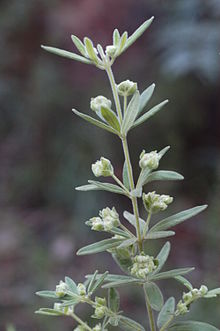en
names in breadcrumbs


Zieria is a genus of plants in the family, Rutaceae. About sixty species have been formally described, all of which are endemic to Australia except for one species which is found in New Caledonia. They occur in all Australian states except Western Australia but the genus is under review and a number of species are yet to be described or the description published. Zierias are similar to the better known genus Boronia but can be distinguished by the number of stamens in the flowers. The name Zieria honours the Polish botanist John Zier.
Plants in the genus Zieria are shrubs or small trees. The leaves are arranged in opposite pairs and are usually compound with three leaflets similar in shape but the middle leaflet slightly larger. The flowers are arranged in groups in the leaf axils and have four fused sepals and four petals alternating with the sepals. There are four stamens (eight in Boronia) and four carpels with their styles fused. The fruit have four lobes, each containing one or two seeds.[2][3][4]
The genus Zieria was first formally described in 1798 by James Edward Smith and the description was published in Transactions of the Linnean Society of London.[1][5] Smith did not nominate a type species but James Armstrong nominated Zieria smithii as the lectotype.[6] The name Zieria honours "John Zier, a Polish botanist, who assisted F.C. Ehrhart in his collection of plants of the Electorate of Hanover, 1780-83, and afterwards worked in London, where he died in 1793."[7][8]
In a 2002 study of the genus, James Armstrong placed each species into one of six groups, based on its morphology. The groups are:
In a 2015 study, using a combination of two non-coding chloroplast DNA regions, Internal transcribed spacer and some morphological characters, Cynthia Morton concluded that the genus as presently described is monophyletic. A tentative arrangement of 32 of Armstrong's 42 species was also suggested:
Zieria citriodora, Z. arborescens, Z. minutiflora, Z. obcordata and Z. pilosa were not able to be resolved in this study.[10]
Plants in the genus Zieria are endemic to Australia, except for Zieria chevalieri, which is found in New Caledonia. Zierias occur in all Australian states except Western Australia.[2]
The species described to date (October 2017) and listed by the Australian Plant Census are:[11]
Zieria parrisiae is listed as "critically endangered" under the Australian Government Environment Protection and Biodiversity Conservation Act 1999. A further eleven are listed as "endangered" and eight as "vulnerable".[12]
 Zieria involucrata in Yengo National Park
Zieria involucrata in Yengo National Park  Zieria compacta growing in a nature reserve near Bolivia
Zieria compacta growing in a nature reserve near Bolivia Zieria is a genus of plants in the family, Rutaceae. About sixty species have been formally described, all of which are endemic to Australia except for one species which is found in New Caledonia. They occur in all Australian states except Western Australia but the genus is under review and a number of species are yet to be described or the description published. Zierias are similar to the better known genus Boronia but can be distinguished by the number of stamens in the flowers. The name Zieria honours the Polish botanist John Zier.
Zieria es un género con 144 especies de plantas fanerógamas perteneciente a la familia Rutaceae.
Son nativos de Australia a excepción de una especie que se encuentra en Nueva Caledonia. El género, que está estrechamente relacionado con el género más conocido Boronia, está nombrado en honor de John Zier, un botánico polaco.
Zieria es un género con 144 especies de plantas fanerógamas perteneciente a la familia Rutaceae.
Son nativos de Australia a excepción de una especie que se encuentra en Nueva Caledonia. El género, que está estrechamente relacionado con el género más conocido Boronia, está nombrado en honor de John Zier, un botánico polaco.
Zieria est un genre de plantes de la famille des Rutaceae, originaire d'Australie à l'exception d'une espèce originaire de la Nouvelle-Calédonie. Ce genre qui est très proche du genre Boronia porte le nom du botaniste polonais John Zier.
Zieria est un genre de plantes de la famille des Rutaceae, originaire d'Australie à l'exception d'une espèce originaire de la Nouvelle-Calédonie. Ce genre qui est très proche du genre Boronia porte le nom du botaniste polonais John Zier.
Zieria is een geslacht uit de wijnruitfamilie (Rutaceae). Alle soorten zijn endemisch in Australië, op een soort na die voorkomt in Nieuw-Caledonië.
Zieria is een geslacht uit de wijnruitfamilie (Rutaceae). Alle soorten zijn endemisch in Australië, op een soort na die voorkomt in Nieuw-Caledonië.
Zieria é um género botânico pertencente à família Rutaceae.[1]